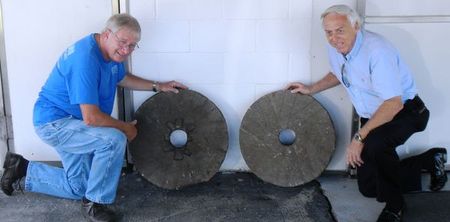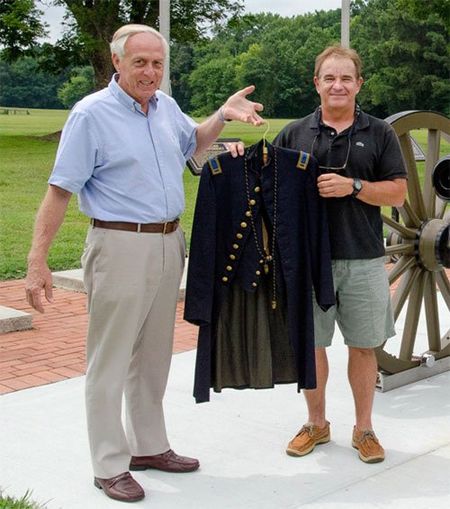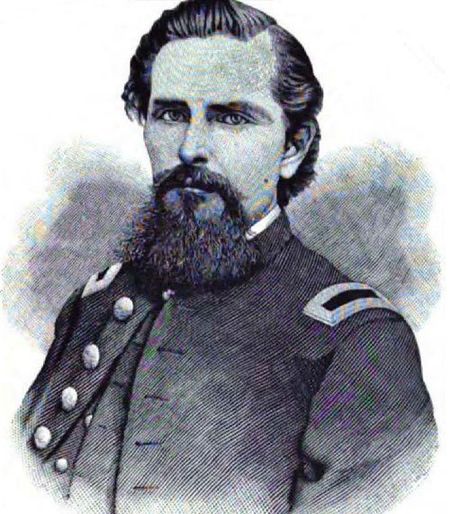What we have created is in thanks to those who have donated
Through the generosity of others we have built the battlefield & museum to what it is today. With continued support we will build it into something even greater for future generations.
Reach Out
I want to support the musuem !

Purdie Family Mill Stone Artifact Donation
Mr. John W. Purdie of High Point, NC, stopped by the Averasboro Civil War Museum on Wednesday, August 20, 2014, to make another significant contribution of artifacts to the Museum. Purdie brought with him mill stones used for grinding grain at the famous Purdie Plantation in Bladen County, NC (near Tar Heel). The Purdie family had made significant contributions to the Averasboro Museum in past years consisting of the uniform, valise, canteen, medicine chest, and sword of the famous Colonel Thomas J. Purdie who commanded the 18th North Carolina, the Confederate Unit which fired (“friendly fire”) upon their own General Stonewall Jackson at the Battle of Chancellorsville in 1863. Colonel Purdie, while engaging in warfare, was himself killed at the Battle of Chancellorsville.
John W. Purdie, who once lived in Harnett County, in making the contribution of the mill stones said, “This Museum is really doing a great job of preserving history and making artifacts available for public viewing so the people who visit, can learn history from our past ancestors.” Purdie noted, too, that the mill stones probably were first put into service about the time of the founding of our country.
The Purdie Plantation, near the town of Tar Heel, NC, was owned by the locally prominent planter Purdie Family from 1796 until 1946. The Purdie Plantation House was evidently built between 1803 and 1809 for James S. Purdie. James S. Purdie died in February, 1818, and left to his son James B. Purdie his plantation with all the plantation tools. In his will of 1834, James B. Purdie, left to his wife Anna Maria, a portion of his real and personal property. It is said that Anna Maria Purdie owned 500 acres of improved property and 2,812 acres of unimproved property. In 1849 the plantation produced 1700 bushels of corn, 1500 pounds of rice and raised much livestock. One of her sons was the famous Colonel Thomas J. Purdie, from his service in the Civil War; the other was John W. Purdie, who aided his mother in the managing of the plantation.
C.C. Livingston, the Director of Operations for the Averasboro Museum, in accepting the mill stones for the Averasboro Battlefield Commission, said, “The members of the Purdie Family have been very generous to the Averasboro Battlefield Commission in their contribution of artifacts for us to display at the Museum. With their help and the help of other contributors we have become a museum with an incredible collection of artifacts. Our thousands of visitors annually frequently comment that we have one of the best collections of artifacts that they have ever seen in any museum. We are deeply indebted to the Purdie Family for helping us to acquire that reputation for our museum.”
Picture: Museum volunteer, Cecil Wade (left) and Averasboro Museum Director of Operations, C. C. Livingston, proudly display the two mill stones from the Purdie Plantation.
"The value of a man resides in what he gives and not in what he is capable of receiving."
Albert Einstein

Averasboro Receives Union Officer’s Uniform and Other Personal Artifacts
The Averasboro Civil War Museum has received a permanent loan of the Union uniform and related personal items of Lieutenant Allen Gardiner, a valiant officer in the Union Army during the Civil War. Lieutenant Gardiner was from a distinctive family from Rhode Island whose heritage went back to the colonization of Rhode Island during the seventeenth century. It was placed on permanent loan to the museum by the Keith C. Gardiner, Jr. family of Fayetteville, NC. Allen Gardiner was the great-great-grandfather of Keith Gardiner, Jr. Allen Gardiner, and therefore Keith Gardiner, Jr.’s lineage go all the way back to the founding fathers of the United States when George Gardiner in 1636 was a settler in the English colony at Jamestown Island, Rhode Island.
Lieutenant Gardiner was a Union soldier who had many unique experiences during the duration of the Civil War between 1861and 1865. He was at first an artilleryman having served with the Battery E, First Rhode Island Light Artillery. Gardiner went into service as a corporal, was promoted to sergeant and was an original member of Battery E which was activated September 23, 1861. Because of his inability to ride a horse, at Gardiner’s request he accepted a demotion back to corporal.
Gardiner was discharged from Battery E, First Rhode Island Light Artillery, taking leave on June 4th, 1864. Gardiner had passed the Casey board on February 2nd 1864, allowing him to be in line for promotion to officer as second lieutenant. Upon leaving Battery E, he went back to Rhode Island, spending time with friends, until June 24th when his commission reached him bearing the date, May 11, 1864. He was instructed to report immediately to the Charleston, SC area.
While Gardiner saw service as a non-commissioned officer in artillery Battery E, First Rhode Island Light Artillery, he engaged in such battles as Williamsburg, Gaines Mill, Malvern Hill, Bull Run, Fredericksburg, Chancellorsville and Gettysburg. One ironic thing about the permanent loan of this uniform is that the Averasboro Museum also has among its artifacts a pristine Confederate uniform that was once worn by Colonel Thomas Purdie, of Tar Heel, NC. Colonel Purdie and Lieutenant Gardiner would have been on opposite sides of the battle at Chancellorsville.
During Lieutenant Allen Gardiner’s service he fought next to a Congressional Medal of Honor recipient at Chancellorsville, JOHN K BUCKLYN, who was First Lieutenant, Battery E, 1st Rhode Island Light Artillery. Place and Date of his action: At Chancellorsville, Va., 3 May 1863.

Bucklyn’s Citation reads as follows:
“Though himself wounded, gallantly fought his section of the battery under a fierce fire from the enemy until his ammunition was all expended, many of the cannoneers and most of the horses killed or wounded, and the enemy within 25 yards of the guns, when, disabling one piece, he brought off the other in safety. ”
On July 8th, 1864, Gardiner accepted a commission as second lieutenant, Company F, Twenty-sixth United States Colored Troops doing service in the Charleston, SC area. This regiment had begun service at Beaufort, SC on April 13, 1864 and the regiment was ordered back to Beaufort, SC, January 2, 1865. Gardiner served in this regiment until the 21st of June, 1865, when he was transferred to the 46th regiment, (also colored). He mustered out of service a first lieutenant on August 28, 1865. The 26th United States Colored Troops was a regiment consisting of all colored soldiers except the officers, who were white. The unit, while in the Charleston area had expeditions to Johns and James Islands, Burden’s Causeway, and action at Devaux’s Neck, Tillifinny Station and McKay’s Point.
A similar unit to the 26th United States Federal Colored Troops was the infamous 54th Massachusetts Volunteer Infantry, the first formal unit of the US Army to be made up entirely of African-American men, which was featured in the 1989 movie “Glory” starring actor Denzel Washington, at the Battle of Fort Wagner on Morris Island, portraying the role of the first African-American to be awarded the nation’s highest award for bravery, the Congressional Medal of Honor, on July 18, 1863, William H. Carney.
Lieutenant Allen Gardiner, could not have possibly seen into the future, but one of the men who saw service with him in the 26th United States Colored Troops was David Carll, who was the great-great-grandfather of the first African-American Miss America, Vanessa Williams.
After the war’s end, Allen Gardiner, was married to Mary Kate Carr, daughter of Peleg C. Carr and Catherine W. Weeden. He and his wife were both from Jamestown, Rhode Island. The second year after the war, Lieutenant Gardiner went south to live on a plantation in Christ Church parish near Charleston, South Carolina, and planted cotton for a number of years. Gardiner returned to Jamestown and his family in 1875. His health, after his return, began to fail steadily. In 1882, he went to Florida for health purposes, returning in July, of 1883. Six weeks later, September 14, 1883, he died of consumption.
Upon completing the paperwork for placing the artifacts on permanent loan with the Averasboro Battlefield Museum, Keith Gardiner, Jr. said, “I feel good about placing these artifacts with the Averasboro Museum. They have been resting at my house in Fayetteville with very few people able to see them. Why not place them with a Civil War museum which exists to preserve history and to educate the thousands of public citizens who visit with them annually. I am very happy to place them where many people can view them.”
C.C. Livingston, the Director of Operations for the Averasboro Museum, said, “We gratefully accept these artifacts to be put on display here. Our charge calls upon us as our motto states, to preserve history for the future, and to tell the story of the Battle of Averasboro and the many brave soldiers, both Union and Confederate, who fought here, many of them being wounded or killed. The Averasboro Battlefield Commission is appreciative that Mr. Gardiner thought about us when he decided to put these artifacts on public display.”
"The value of a man resides in what he gives and not in what he is capable of receiving."
Albert Einstein
